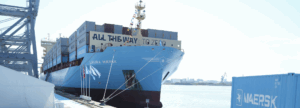New report from UMAS, UCL and GMF shows that Green Shipping Corridors will need additional support under a global fuel standard.
Under current and prospective policies from the International Maritime Organization, European Union, and US, the business case for green shipping corridors could improve markedly, but not sufficiently, according to a new report published by UMAS, UCL and the Global Maritime Forum (GMF).
Titled Building a Business Case for Green Shipping Corridors, the report looks at the significant commercial challenges associated with green shipping corridors, how these could change under future regulation, and what additional support may be needed to ensure the viability of such projects.
Green shipping corridor projects, which focus on initiating the maritime value chain for scalable and sustainable fuels such as hydrogen-derived e-ammonia and e-methanol, have thus far faced an insurmountable cost gap.
Against the backdrop of an evolving global and regional policy landscape, the business case for such first mover initiatives will begin to improve, but targeted support will be needed to ensure uptake of e-fuels.
The report emphasises the important role of regulation in enabling shipping’s energy transition and the wider implications for the industry operating under a future compliance regime where fleet and bunkering strategies will need to become more sophisticated.
Policies such as the IMO’s new global fuel standard, the EU’s Emissions Trading Scheme (ETS), and the US Inflation Reduction Act (IRA) will play a critical role in reducing costs for green shipping corridors but fall short of fully bridging the gap between the cost of e-fuels and the cheapest solution to meet compliance.
The report explores the potential opportunities and options that could be available for green shipping corridors in three different shipping sectors—gas carriers, container ships, and bulk carriers—to highlight how public and private efforts could accelerate early adoption of e-fuels.
According to UMAS, the scenarios explored reveal that while biofuels and blue ammonia are lowest cost options over the near term, scalable e-fuels such as e-ammonia are expected to become increasingly competitive as production costs fall and compliance requirements tighten, indicating that targeted support would only be required over the short term.
With 62 green shipping corridors initiatives already announced, support for these early mover projects could enable significant strides to be made in the development of sustainable fuel production and in investment in the storage, bunkering, and port infrastructure required to decarbonise the wider shipping industry later in the transition.
Deniz Aymer, Senior Consultant at UMAS, said, “Upcoming regulation will shift the business case for green shipping corridors – as well as shaping how the wider shipping industry approaches compliance.
“To fully bridge the cost gap, however, targeted support for e-fuels is needed. But this short-term support will pay future dividends by ensuring that scalable and sustainable fuels are available to the wider industry when needed.”
To accelerate progress, the report outlines actionable solutions for industry and policymakers.
It highlights how business models will need to adapt under incoming regulation and how long-term commitments from cargo owners and ship owners and operators can help de-risk investment and drive e-fuel adoption. Strategic partnerships across the value chain will be essential for sharing risks and rewards, ensuring a more equitable cost distribution while advancing green shipping corridor projects.
Despite this, the business case for green shipping corridors will remain challenging without targeted measures to support the uptake of e-fuels.
“Mechanisms such as Contracts for Difference (CFDs), e-fuel auctions, and/or multipliers for overcompliance with e-fuels will be crucial to the short-term viability of these initiatives,” the new report highlights.
Economic support could be underwritten by the IMO through revenues raised by a levy on shipping industry emissions.
The report notes that in the absence of a global levy, national governments may need to step in to directly support corridor projects.



